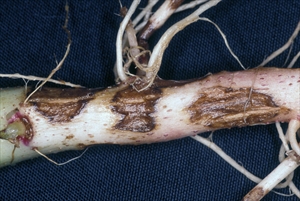Black scurf, rhizoctonia canker
Pacific Pests, Pathogens, Weeds & Pesticides - Online edition
Pacific Pests, Pathogens, Weeds & Pesticides
Potato black scurf (295)
Rhizoctonia solani. It is also called Thanatephorus cucumeris, which is the sexual state; it may occur on the lower stems of potato. There are a number of strains, and the common one on potato is referred to as AG3.
Wherever potatoes are grown. It is present in Australia and Papua New Guinea.
Wide; causing brown patch of turf, sheath rot of rice, rots of cucumber and sugarbeet, and damping-off (pre and post-germination) of seedlings of many plants. Note, there are strain differences and only some strains infect potato.
A fungus causes the damage. Rhizoctoia solani is common in most soils. It exists as cottony fungal growth (called 'mycelium') in decaying plant remains, or as resting 'sclerotia' - cottony growth surrounded by a thick black rind, protecting the sclerotia from other soil organisms. The sclerotia, which are first formed on the surface of the tubers, give the disease its name 'black scurf'.
Two types of symptoms occur below ground. Symptoms occur on stems and 'stolons' first, and then on tubers later in the season.
On the stolons, which bear the tubers, and on stems that bear the leaves, dry, brown, slightly sunken, elongated spots occur (Photos 1&2). The spots become cankers and limit transfer of starch from leaves to tubers. If the cankers spread around the stems, they wilt and die; and if they spread around the stolons, they cause dieback of the tips. Stems may be attacked and killed while still below ground. Roots may also be attacked and destroyed.
On the tubers, firmly attached, black, irregular-shaped sclerotia form, developing as the tubers mature. They can range in size from small, flat, barely seen spots, to large, raised, lumps. They do not penetrate the tuber.
Above ground, plants may be stunted, and leaves curled. There may be small tubers formed in the junction between leaf and stem.
Cool, wet weather, for a few weeks after planting, with temperatures about 18°C, and soil pH of 7 or less favour infection. The disease is worse if harvest is delayed.
Spread of the black scurf occurs over short distances in soil on machinery or on shoes, either as fungal growth or sclerotia. Long distance spread occurs with the movement of fresh potatoes or those used for seed which are contaminated with sclerotia. Survival occurs in plant residues left after harvest and as sclerotia in the soil.
A serious disease in many parts of the world, both for potatoes grown for the fresh market and those grown for seed. The disease causes poor stands, stunted plants, and reduced tuber number and size. Its impact depends on the soil conditions after planting with cool, wet soils resulting in economically significant damage.
Look for wilting plants, and look for dark brown to black spots on the stems below ground, and similar spots on the stolons. Look for black, irregular-shaped, sclerotia fixed to the tuber surface. Look for the mycelium of the fungus under the microscope, and see the right-angle branching, narrowing of the fungal threads at the branch and, typically, a cell wall a short distance from the branch (Photo 4).
CULTURAL CONTROL
Before planting:
- Choose seed carefully, preferably healthy seed certified by government agencies.
- Wait until the seed has sprouted before planting.
- If possible, plant in soils where the disease has not been recorded previously.
- If possible, choose fields with good drainage, as they are less likely to become waterlogged, and will warm up faster.
- Avoid cold, wet soils. Cover with as little soil as possible (maximum 5 cm) to increase the speed of shoot growth; this reduces the time when the fungus can infect.
- Make sure that there are no volunteer potatoes growing in the land, and remove weeds, e.g., nightshade.
- Add well-composted organic matter to the soil to encourage microbes to complete with black scurf.
During growth:
- Harvest as soon as the vines are killed as sclerotia form late, and become larger over time. Remove the 'tops' with a knife, rather than using herbicide.
- Do not leave tubers in the soil so that they become 'volunteers', increasing the number and size of sclerotia, and provide a source of disease for the next crop.
After harvest:
- Use a 3-year crop rotation; rotate with maize, onions, grasses or cereals (e.g., barley). Mustard grown and then ploughed into the soil (just before flowering) may be beneficial.
- Prepare land early so that remains of crops have time to rot down before planting.
- Collect and destroy the remains of the crop.
RESISTENT VARIETIES
None known
CHEMICAL CONTROL
In Australia, the fungicide pencycuron is sold especially for the control of black scurf on seed for planting. Mancozeb treatment of the seed may be useful to reduce black scurf, and protect the shoots when they sprout.
____________________
When using a pesticide, always wear protective clothing and follow the instructions on the product label, such as dosage, timing of application, and pre-harvest interval. Recommendations will vary with the crop and system of cultivation. Expert advice on the most appropriate pesticide to use should always be sought from local agricultural authorities.
AUTHOR Grahame Jackson
Information from Diseases of vegetable crops in Australia (2010). Editors, Denis Persley, et al. CSIRO Publishing; and from Wharton P, Wood E (undated) Rhizoctonia stem canker and black scurf of potato. University of Idaho Extension. (https://www.cals.uidaho.edu/edcomm/pdf/CIS/CIS1198.pdf). Photos 1-3 Gerald Holmes, California Polytechnic State University at San Luis Obispo, Bugwood.org. Photo 4 Bouchek-Mechiche K (2016) Black scurf. GNIS/INRA. (https://www.potato-tuber-blemishes.com/Symptoms/Pitted-or-raised-symptoms/Black-scurf).
Produced with support from the Australian Centre for International Agricultural Research under project PC/2010/090: Strengthening integrated crop management research in the Pacific Islands in support of sustainable intensification of high-value crop production, implemented by the University of Queensland and the Secretariat of the Pacific Community.







